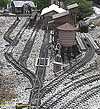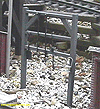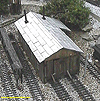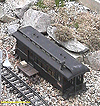Scenery
:
Buildings
Detailing a Large Scale Engine Terminal
May 28, 2003


By Randy Mower |
Author
Bio
Many garden railroaders have built some sort of small engine terminal on their large-scale layouts. Most are just a one or two-stall engine house and maybe a water tower or coal tower. The addition of a few additional details will allow you to make a credible representation of an engine terminal.
|
Many garden railroaders have built some sort of small engine terminal on their large-scale layouts. Most are just a one or two-stall engine house and maybe a water tower or coal tower. The addition of a few additional details will allow you to make a credible representation of an engine terminal. Steam Engines
Coal, Wood or Oil (fuel)
Sand
Water
Lubricating Oil Supply
Ash Pit
Engine house or Round house Steam engines required a lot of maintenance and even small facilities needed some basic capabilities to facilitate day-to-day operations. The most common type of fuel in steam engines was coal, so some sort of means was required to move coal into the tender of the engine. The most common method of doing this was to construct some sort of structure, commonly called a tipple, to hold coal above the tracks and use gravity to deposit it into the tender. Coal would typically arrive in hoppers and would be unloaded into some sort of pit or chute from which it would then be lifted into the above track storage hopper. Pola makes a nicely detailed coal tower kit, which fits in nicely for just about any small to medium sized terminal. 
Click for larger picture In my engine terminal I built a delivery track which goes up a small ramp and onto a trestle which allows unloading of coal and sand for my service facilities. 
Click for larger picture
If you are running oil burners all you will need is some sort of pump house and standpipe for transferring the oil into the tenders and perhaps some sort of storage tank.
The next item needed for operation of steam engines is sand. Steam engines had a sand dome on top of the boiler with a delivery system of tubes to dispense the sand in front of the drivers when needed for traction. The sand being put in the engines had to be dry to allow for it to flow freely. When sand was delivered it was often damp or stored outside. This "green" sand as it was called would be dried in a sand processing building and then was blown or conveyed into an above track storage bin where it could then be transferred into the steam engines. This bin was sometimes incorporated in the coal tipple structure or sometimes it stood alone. The sand house in my terminal was scratch built; however, a number of suitable kits are available as well. Water is used in great quantities by steam engines and engines would have their tanks filled at the terminal before going out on the road. You will want some sort of water tower or standpipe in your terminal. Steam engines had a lot of moving parts and consequently required a lot of lubrication. I just sat a few 55 gallon drums around my terminal and put a couple on their sides on a rack with spigots to allow my little engine service people to fill their oilcans. In larger facilities there would often be a separate building to store lubricating fluids. When a steam engine would arrive at the terminal after a run the fire would be "dropped" into an ash pit before it would be moved to the engine house. A steam engine had an ash pan with grates, which would rotate to allow the clinkers and hot coals to drop out of the bottom. The ash pit was some sort of pit below the track, usually made of concrete, stone or some other non-flammable material, which provided a safe location to deposit the hot coals. Ash pits would of course fill up and would need to be emptied. Larger terminals had some sort of conveyer or hopper system to transfer the ashes to a hopper car or drop bottom gondola for removal. In smaller facilities the pits would be emptied by hand or by using a small portable conveyer. The ash pit in my terminal was made out of wood and painted to look like concrete. 
Click for larger picture I made support beams of wood and removed the ties from a section of track and installed it over the pit. As a special touch I added a small clear plastic dome in the bottom of the pit with a red light bulb in it and covered it with ashes to simulate the glow of hot coals. I also made a firebox servicing tool rack, which I detailed with Ozark Miniatures parts. 
Click for larger picture
Because of the vulnerability of steam engines to the weather, when they were not running an engine house which the locomotive could be driven into was used to protect them from the elements. This could be a simple engine shed or an elaborate roundhouse, complete with a turntable. I scratch built the two-stall wooden engine house on my layout. 
Click for larger picture There are a number of nice kits available for engine houses including an expandable brick one from Piko. Diesel Engines
Diesel Fuel
Sand
Water
Lubricating Oil 
Click for larger picture Diesel engine service facilities, especially early ones, are commonly old steam engine facilities, which were adapted to use by diesels. Often the coal tipple would be removed, but if it had an integrated sanding facility it would be retained. Some sort of fueling standpipe or fuel hose is needed for fueling the engines and there would usually be some sort of pump house to control the flow of the fuel from the storage tanks. Diesels use sand just like steam engines, if pre-existing steam sanding facilities were not used some sort of free standing sand bin to service the diesels would be used. Diesels used water for the cooling system but usually a small hose sufficed to provide water when needed. Diesels also required lubricating oil and engine oil, so some sort of oil storage building was needed. Other Terminal Details
Air supply
Fire Hose
Stores
Engine Wash
Shop
Regardless if servicing steam, diesel or both, some other items that are common to engine service facilities include an air supply, which would usually require some sort of pump house, which would have been electrically, or steam powered. A fire fighting system that would usually be a series of small shacks (painted red) with fire fighting hose inside them. I made a little fire hose shed out of a block of wood with a piece of corrugated plastic for a roof. 
Click for larger picture The stores department would keep a supply of other consumables such as cotton, waste for cleaning, fusees, torpedoes, drinking water, etc. The frequency that engines would be washed depended on the pride and operating budget of the railroad. Many larger railroads washed their engines on a regular basis and some (like the Western Maryland) even waxed them regularly. Washing facilities could consist of an automatic system with rotating brushes and sprayers, or may be as simple as a pressure hose and a long handled brush. Last but not least were the shops. Depending on the size of the facility and the complexity of the repairs performed on site there could be quite a few buildings to store all the specialized tools and supplies and provide an base of operations for all the people who did the work. On my railway my shop is just a small addition on the side of the two-stall engine shed as any major repairs are done at a different location. I also converted an old Aristocraft combine into my yard office and stores department. 
Click for larger picture There you have it, try adding a few extra buildings or details to your garden railway engine terminal for some extra realism. Top of Page
|



